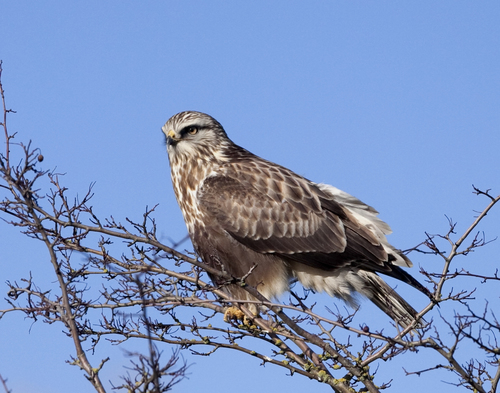
Rough-legged Hawk
The Rough-legged Hawk (*Buteo lagopus*) is a medium-to-large bird of prey that breeds in the Arctic and subarctic regions of North America and Eurasia. It is named for its feathered legs, an adaptation to the cold environments it inhabits. This hawk plays a crucial role in its ecosystem as a predator of small mammals, particularly lemmings and voles, whose populations can significantly influence the hawk's breeding success and movements. It is known for its distinctive hovering flight while hunting, a behavior less common among other *Buteo* species.
46-60 cm
Length
120-153 cm
Wingspan
Least Concern
Conservation Status
Distribution
Breeds in the Arctic and subarctic regions of North America, Europe, and Asia. Migrates south for the winter, reaching the northern United States, central Europe, and central Asia. Altitudinal range varies from sea level to mountainous tundra.
Lifespan
Up to 18 years in the wild, potentially longer in captivity. (Consult a wildlife expert for definitive data)
Rough-legged Hawk's Habitat
Habitat Types
Tundra, Taiga, Open grasslands, Marshes, Agricultural fields (during migration and winter)
Climate Zones
Arctic, Subarctic, Temperate (during migration and winter)
Adaptations
Feathered legs provide insulation in cold climates. Their ability to thrive in open habitats with sparse vegetation is key to their hunting strategy.
Variations
There are subtle variations in plumage and size among different populations, with some classifications recognizing up to four subspecies: *B. l. lagopus*, *B. l. sanctijohannis*, *B. l. kamtschatkensis*, and *B. l. menzbieri*.
Appearance
Breeding Plumage
Plumage is highly variable, with light and dark morphs. Generally, adults have a pale head, a dark belly band, and a white tail with a broad, dark subterminal band. Juveniles are typically buffer overall.
Seasonal Feather Changes
Some seasonal variation, with plumage potentially appearing slightly worn by the end of the breeding season.
Sex Based Plumage Differences
While both sexes exhibit a range of plumages, females tend to be larger with slightly different markings.
Notable Features
Feathered legs extending down to the toes., Distinctive white tail with a dark band., Dark wrist patches visible in flight., Relatively small bill compared to other *Buteo* species.
Diet and Feeding
Primary Foods
Lemmings, Voles, Other small rodents, Small birds (occasionally), Insects (during breeding season)
Foraging Behavior
Primarily hunts by hovering over open ground, scanning for prey. Also uses perch hunting and occasionally still-hunting from the ground.
Specializations
Exceptional hovering ability allows it to hunt effectively in open habitats with limited perches. Keen eyesight and hearing aid in prey detection.
Seasonal Diet Variations
Diet shifts with prey availability. During breeding season, heavily reliant on lemming and vole populations. In winter, may take a wider variety of prey, including birds and carrion if rodents are scarce.
Behavior
Social Structure
Generally solitary or in pairs during the breeding season. May form loose flocks during migration and in wintering areas with abundant food.
Communication
Vocalizations include a high-pitched 'kee-yer' call., Aerial displays for courtship and territorial defense., Body postures, such as raising or lowering the head.
Migration
A long-distance migrant, traveling thousands of kilometers between breeding and wintering grounds. Migration timing is influenced by weather and prey availability.
Territorial or Group Behaviors
Territorial during the breeding season, defending nesting sites from other Rough-legged Hawks and potential predators. Territory size varies depending on prey density.
Conservation
Threats
Climate change (affecting prey populations and habitat), Habitat loss and degradation (in wintering areas), Collisions with vehicles and wind turbines, Pesticide exposure (indirectly through prey)
Protection Programs
Monitoring of populations during breeding and migration., Habitat conservation efforts in key breeding and wintering areas.
Local National Laws
Protected under various national and international laws, including the Migratory Bird Treaty Act in the United States and Canada.
Population Trend
Stable
Population Estimates
Global population estimated to be between 50,000 and 500,000 individuals (IUCN).
Interesting Facts
They are one of the few raptors that regularly hover while hunting.
This allows them to hunt effectively in open areas with few perches.
Their breeding success is closely tied to lemming populations.
In years with low lemming numbers, they may not breed at all or have very small clutches.
They can migrate thousands of miles.
Some individuals travel from the Arctic to the southern United States and back each year.
Their feathered legs are an adaptation for cold weather
The feathers help insulate their legs in freezing temperatures.
Faqs about Rough-legged Hawk
What is the difference between a Rough-legged Hawk and a Red-tailed Hawk?
Rough-legged Hawks have feathered legs down to their toes, while Red-tailed Hawks have bare legs. Rough-legged Hawks also have a distinctive white tail with a dark band, and they often hover while hunting, which Red-tailed Hawks rarely do.
Where can I see a Rough-legged Hawk?
During the breeding season, you can find them in the Arctic and subarctic regions. In winter, they migrate south and can be seen in open habitats across the northern United States, southern Canada, Europe, and Asia.
Are Rough-legged Hawks endangered?
No, they are currently listed as Least Concern by the IUCN. However, their populations are monitored due to potential threats from climate change and habitat loss.
Do they only eat lemmings?
While lemmings are a crucial part of their diet, particularly during breeding, they also eat other small rodents, birds, and sometimes insects. Their diet varies depending on prey availability.
Copyright @ Nature Style Limited. All Rights Reserved.
 English
English